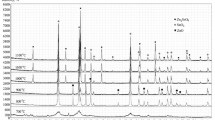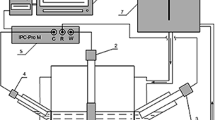Summary
-
1.
The action of alkyl-substituted ammonium chlorides (secondary-, tertiary- and quaternary-salt) on negative silver iodide sol has been studied.
-
2.
It has been found as a whole that the coagulation values of these electrolytes decrease with the increase of the number of total carbon atoms of alkyl chains contained in a molecule, and that the coagulation values of the electrolytes of the same carbon atom number are put in the following order: primary amine salt >secondary amine salt >tertiary amine salt = quaternary ammonium salt.
-
3)
It has been found that tri- and tetra-n-butylammonium chlorides show the same action in coagulating silver iodide sol as n-alkylammonium chlorides with alkyl chains of more than 12 carbon atoms, that is, the coagulation values of the former electrolytes are coincident with those of the latter electrolytes, and that these values decrease with the decrease of the sol concentration. It has been further found that the coagulum once formed is peptized at much higher concentrations of these electrolytes than in the case of n-alkylammonium chlorides.
-
4.
It is suggested that the coagulating action of the alkyl-substituted ammonium chlorides may be mainly determined by the number of total carbon atoms contained in a molecule, while the peptizing action may be influenced by other structural factors.
Zusammenfassung
-
1.
Es wurde die Wirkung von Alkyl- (methyl-, äthyl-, butyl-)substituierten Ammoniumchloriden (sekundär, tertiär, quaternär) auf die Stabilität vom negativen Silberjodid-Sol untersucht.
-
2.
Es wurde festgestellt, daß der Flockungswert dieser Elektrolyte mit der Zunahme der gesamten Kohlenstoffatomzahl der Alkylketten abnimmt und daß die Flockungswerte der Elektrolyten von verschiedener Struktur und gleicher Kohlenstoffatomzahl in der folgenden Reihenfolge geordnet sind: primäre Aminsalze >sekundäre Aminsalze >tertiäre Aminsalze = quaternäre Ammoniumsalze.
-
3.
Es wurde weiter gefunden, daß Tri- und Tetrabutylammoniumchloride die gleiche Flockungswirkung wie die Dodecyl-, Tetradecyl- und Hexadecylammoniumchloride zeigen, d. h., die Flockungswerte in den beiden Fällen gleich sind, und daß sie mit der Abnahme der Solkonzentration abnehmen. Tri- und Tetrabutylammoniumchloride können ebenfalls die Flockung peptisierend wirken, wie n-Alkylammoniumchloriden, doch bei noch höheren Konzenzentrationen.
-
4.
Die experimentellen Ergebnisse deuten darauf hin, daß die Flockung hauptsächlich durch die gesamte Kohlenstoffatomzahl in dem Elektromolekül bestimmt wird, während die Peptisation durch andere Struktur-faktoren beeinflußt wird.
Similar content being viewed by others
References
Tamamushi, B. and K. Tamaki, Kolloid-Z. 163, 122 (1959).
Freundlich, H. and V. Birstein, Kolloid-Beih. 22, 95, (1926).
Freundlich, H. and G. N. Slottman, Z. physik. Chem. 129, 305 (1927).
Burton, E. P. and E. Bishop, J. Physic. Chem. 24, 701 (1920).
Tamaki, K. (Unpublished data).
Meguro, K., Nippon Kagaku Zassi (J. Chem. Soc. Japan, Pure Chem. Sec), 77, 77 (1956).
Author information
Authors and Affiliations
Rights and permissions
About this article
Cite this article
Tamaki, K. The action of alkyl-substituted ammonium chlorides on negative silver iodide sol. Kolloid-Zeitschrift 170, 113–116 (1960). https://doi.org/10.1007/BF01525169
Received:
Issue Date:
DOI: https://doi.org/10.1007/BF01525169




